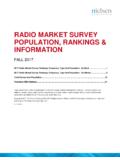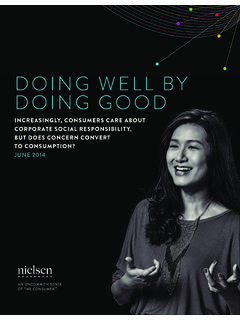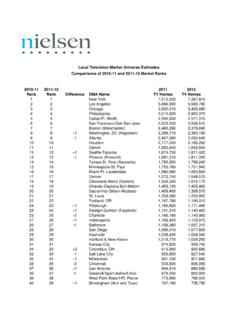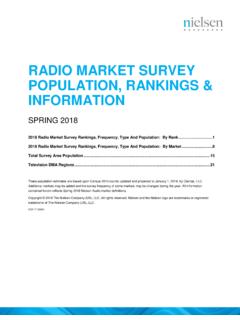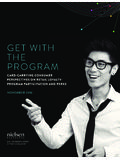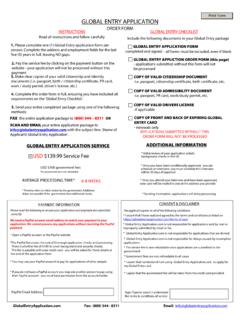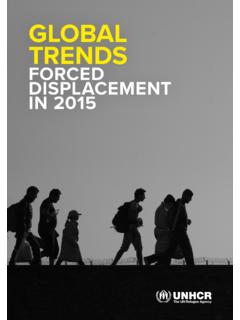Transcription of OH, BABY! - Worldwide | Nielsen
1 1 global baby CARE REPORTC opyright 2015 The Nielsen CompanyOH, BABY! TRENDS IN THE baby FOOD AND DIAPER MARKETS AROUND THE WORLDAUGUST 20152 global baby CARE REPORTCONTENTSINTRODUCTION AND METHODOLOGYPART I: THE baby FOOD AND FORMULA MARKET AROUND THE WORLDI ncreasing prosperity and modernization drives baby food growth .. 6 Packaging innovation and organic options drive sales .. 12 The value of trusted advisors .. 14 Brand name, nutrition and safety are important purchase criteria .. 16 Price is a dominant driver in Western markets.
2 18 Brand loyalty is fleeting .. 20 Strategies for success in the baby food and formula category .. 22 PART II: THE baby DIAPER MARKET AROUND THE WORLDD iaper growth is strongest in developing markets .. 25 Diaper pants popularity is on the rise .. 28TV + diapers = strong influence .. 30 Function first for diapers .. 33 Price is a top priority .. 34 What s in a name? .. 36 Strategies for success in the diaper category .. 37 PART III: E-COMMERCEAsia leads the way in online purchasing .. 39 Strategies for success in e-commerce.
3 423 global baby CARE REPORTC opyright 2015 The Nielsen CompanyLITTLE CONSUMERS, BIG CHALLENGESAROUND THE WORLDDIAPERS: Almost half of baby food (46%) value sales come from North America and Europe, while Asia-Pacific accounts for 49% of baby food and 53% of formula value sales.* Sales of baby food pouches and organic products are growing strongly, increasing 28% and 26%, respectively, from a year ago. Word-of-mouth communications is the most commonly cited source for information about baby food/formula. Brand name, nutrition and safety are the most important purchase criteria for baby food.
4 Price is an important purchase consideration in developed markets. More than half (51%) of diaper value sales come from North America and Europe, but the most rapid growth is happening in developing countries.* Diaper pants are the fastest-growing segment, with sales increasing 20% over the previous year. Sales are primarily concentrated in Asia-Pacific and Europe. Skin protection and comfort are the most important diaper purchase considerations. Seventy percent say they ve switched diaper brands, and price is a key driver in every region except Asia-Pacific.
5 baby FOOD/FORMULA:*See Methodology section for list of countries included in the baby CARE REPORTT here are few things as precious as a newborn baby , and parents want the very best for their child from the food they put in their mouths to the diapers they put on their bottoms. And they re willing to spend for it. Nielsen estimates baby food and formula sales around the world will reach nearly $30 billion in 20151, and the diaper market is estimated to exceed $29 for baby care manufacturers, there s plenty at stake in the battle for baby bucks.
6 Globally, births are declining across all regions. Between 1960 and 2013, birthrates around the world declined 45% on average, according to the World Bank. In addition, parents hearts and minds are not easily won. Competition in the baby care market is stiff, and numerous branded and store-brand products at various price points compete for moms attention. Moreover, the window for purchasing baby care products is relatively short. For example, in developed markets, babies spend an average of three years in the diaper market.
7 In some developing markets, like China, where potty training begins earlier, the timeframe can be even shorter: 14 months on average, according to a 2015 Ad Age report. Despite challenges, opportunities in the baby care market remain sizeable, said Liz Buchanan, director, global Professional Services, Nielsen . Consumers are deeply invested in these categories, and they are highly discriminating about the products they buy for their children. However, to achieve a competitive advantage in a space dominated by only a few major brands, a deep understanding of what s driving product choice is critical.
8 To better understand why consumers select one baby food or diaper brand over another, and to determine what motivates brand-switching behavior, Nielsen polled online respondents in 60 countries who have made a baby care purchase in the past five years. The findings reveal important insights about the path to purchase and identify the online and offline sources most influential in the process. Finally, areas of opportunity and the strategies necessary to win in the global baby care market are THE global SURVEY METHODOLOGYThe findings in this survey are based on online respondents in 60 countries who have children in their household and have made a baby food/formula or diaper purchase in the past five years.
9 While an online survey methodology allows for tremendous scale and global reach, it provides a perspective only on the habits of existing Internet users, not total populations. In developing markets where online penetration is still growing, audiences may be younger and more affluent than the general population of that country. In addition, survey responses are based on claimed behavior rather than actual metered data1 Based on Nielsen sales data for infant nutrition and infant cereal categories in 32 countries and infant formula in 36 countries, which cover an estimated 95% of global baby food and formula value sales.
10 2 Based on Nielsen sales data for baby diapers and wipes in 63 countries, which account for an estimated 90% of global value baby CARE REPORTC opyright 2015 The Nielsen CompanyTHE baby FOOD AND FORMULA MARKET AROUND THE WORLDPART I6 global baby CARE REPORTINCREASING PROSPERITY AND MODERNIZATION DRIVES baby FOOD GROWTHOver 80% of the world s population lives in the developing world, and while global birthrates have steadily decreased across all regions and economic levels over the past 55 years, they remain highest in developing countries, according to the World Bank.

